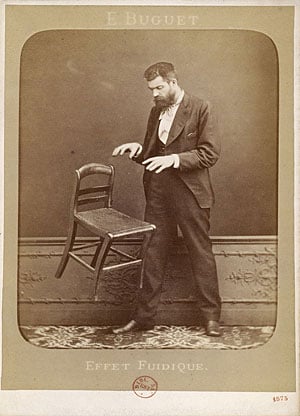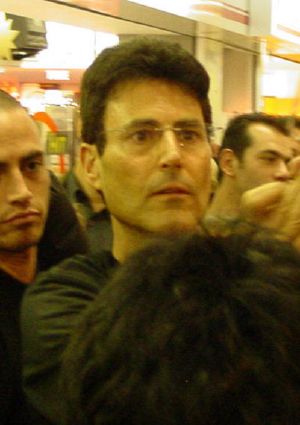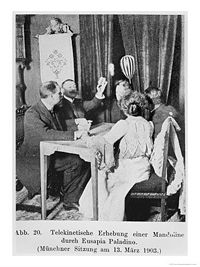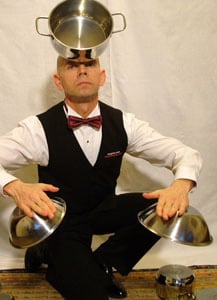Psychokinesis, sometimes referred to as "telekinesis" or "mind over matter," is the ability to influence the movement of matter or energy through mental processes. Psychokinesis, abbreviated "PK," is perhaps most well known for such feats as the bending of spoons, but parapsychologists have found that PK abilities often manifest on a smaller scale. Parapsychology generally refers to these abilities as "psi phenomena," and use techniques such as random number generators to test for them scientifically. While the results of such research indicate the possibility that some of the results may not be attributable to chance, skeptics have continued to expose weaknesses in test design, weaknesses that can be exploited by frauds.
The popularity of those claiming psychokinetic abilities, and the debate about whether or not they have true abilities continues. Those on both sides can at least agree that this indicates a desire on the part of many to believe that human beings are capable of using their minds to directly influence the physical world.
History
Psychokinesis, or PK, is defined as the direct influence of the mind on a physical system.[1] The first term for the ability to move matter through non-physical means, "telekinesis," came into use in the late 1800s. Literally meaning "distant movement," telekinesis referred to the moving of objects by supernatural forces, including spirits and ghosts.
During the Spiritualist Movement of the mid to late nineteenth century, PK phenomena were seemingly everywhere. During séances, tables would move, musical instruments would hover mid-air and play melodies, and chalk would write on a sealed slate. Despite the fact that such phenomena would take place only in the presence of a certain medium, the movement of objects was attributed to spirits and not to any individual ability of the medium. Parapsychologists tend to view such movement as originating from the physical living person, not spirits. Additionally, it must also be mentioned that a great deal of the apparent PK phenomena of the Spiritualist Movement was in actuality nothing more than trickery and conjuring.
During the 1930s, the term "psychokinesis," coined in 1914 by American author Henry Holt, was taken up by famed parapsychologist J. B. Rhine, and soon became the preferred term among parapsychologists. While the two terms are often used interchangeably to refer to the psychic movement of objects (including matter as small as air molecules), PK additionally encompasses phenomena like the influencing of random number generations or the softening of the metal in a spoon (thus enabling the spoon to be more easily bent). PK is also preferred over the more archaic "telekinesis" because of its lack of spiritualist connotations.
Scientific investigation of PK
Starting in 1934, J. B. Rhine, often referred to as the "father of modern parapsychology," carried out a number of experiments at Duke University in North Carolina. In many of his studies he used dice to test for PK. The validity of Rhine's experiments, in PK as well as in other areas, is often debated. Believers claim that, collectively, Rhine's experiments prove the existence of PK with odds against chance of a billion to one. Critics and skeptics point out flawed methodology in the protocol of Rhine's experiments that may have allowed for fraud or manipulation by the subjects. Mechanisms have been designed that show a significant deviation from the theoretical laws of chance, even when no human element is introduced. Because of this, skeptics accuse parapsychologists of attaching more importance to any deviation from the laws of chance than is deserved.[2] Depending on the individual protocol of experiments, it is also possible that precognition, or knowledge of the future, could account for the success of some subjects at choosing the correct number of a dice roll.
PK was later differentiated into two distinct categories: Macro-PK, which consisted of observable events like the movement of a matchbook, and micro-PK, which created weak effects only observable through statistical evaluation. More and more researchers began to focus on micro-PK, using experiments designed around random event generators. One of the first of such random event generators was designed by American physicist Helmut Schmidt. Schmidt's "electronic coin flipper" used the random decay of radioactive particles to generate a "heads" or "tails" result, a technique that was difficult, if not impossible, to manipulate through fraud. Schmidt tested a number of subjects, some of whom did seem to be able to influence the results successfully.[3]
Skepticism
The field of parapsychology has always had to contend with a certain amount of criticism, and the subject of psychokinesis is no exception. Critics and skeptics both argue that parapsychologists often want to believe in a phenomenon so much that they are blinded to flaws in their research. Subjects tested often attempt to manipulate the experiment to create a more chaotic environment, during which a subject is better able to use fraudulent techniques to fool researchers.[4]
In 1979, $500,000 worth of funding was given to Washington University in Missouri for parapsychological research. James Randi, a well known magician and critic of parapsychology, saw this as an opportunity to prove that the lack of properly controlled experiments was not, as many parapsychologists claimed, due to a lack of funding, but rather to flaws in their approach to testing. Randi trained two young magicians, who were then accepted, unknowingly by the investigators, into the experiment. Over the course of four years, the two fake psychics participated in over 160 hours of experiments, and had researchers convinced of their psychic abilities. Once researchers began to institute protocols suggested by Randi to prevent fraud and manipulation, however, the planted subjects were no longer able to create such spectacular results. Randi later commented that the effect of the hoax, termed "Project Alpha," was short lived, and that parapsychologists remain overly susceptible to deception and self-deception.[5]
Magicians like Randi have often volunteered their time and expertise to help create more stringent experimental conditions to guard against trickery. In many instances, subjects that previously performed well are unable to recreate their success under these more strict guidelines. Many supporters of psi phenomena claim that introducing a critical environment or a skeptical researcher searching for fraud creates an environment that is not conducive to successful psi demonstration. Partly as a result of these issues, much of the research into PK has shifted away from the search for an individual with PK ability, and more towards the search for micro-PK abilities in a larger portion of the population.
PK and poltergeists
Many parapsychologists and psychic investigators believe that subconscious PK is often responsible for poltergeist activity. Poltergeists are believed to be either mischievous or sometimes malevolent spirits that make noises, throw objects around the room, and sometimes assault people or animals. Poltergeist activity often begins and ends abruptly, and usually occurs in the vicinity of the same person. Often, this person is a child or adolescent. Researchers theorize that repressed hostilities towards parents or authority can manifest as subconscious PK phenomena in such cases. It has also been suggested that individuals with unresolved mental or emotional issues can create similar effects, which often disappear after the individual undergoes therapy.[6]
Famous individuals with purported PK ability
There are many individuals who have become famous for claiming to have psychokinetic ability. While most have been revealed by skeptics to be frauds, some continue to profess their ability and a significant proportion of the public continues to be fascinated by their performances if not actually convinced in their abilities. Following are some notable examples.
Uri Geller
Uri Geller is most famous for his alleged feats of spoon and key bending, as well as a psychic ability to fix broken watches. Born in Israel, Geller's successful psychic career began in the late 1960s. Geller has claimed he was responsible when the Olympic flame was briefly stuck as it was winched to the top of Stadium Australia during the 2000 Olympics. Geller allegedly focused on the flame for eleven minutes as part of his quest for global nuclear disarmament.[7] He has also claimed he brought the famous London clock tower, Big Ben, to a stop. In 1986, Geller wrote, "It is my intention, as I write this book; to one day bring Big Ben to a dead stop. I will choose my moment carefully because I do not want to damage British heritage." Later, he claims, "indeed, I stopped the Big Ben [in] ... 1989 and ... 1997!" Big Ben, completed in 1858, stopped again in 1997, and once more in 2005.[8] In 2005, the cause of stoppage was unknown, but unusually high temperatures were thought to contribute.[9]
Geller has been accused of using magician's trickery to create his spectacular effects, particularly by magician James Randi. Geller has defended his inability to produce convincing laboratory results by saying, "When I'm put under pressure, I can't perform. When I'm on stage, I'm not under pressure and it happens. ... But in a laboratory where I really want it to happen, it's very hard for me."[10] Critics claim that spoon bending is not a difficult feat for a talented conjurer. Geller is often accused of using misdirection and sleight of hand to achieve his allegedly psychic results. His claims of being able to psychically repair watches were also brought under scrutiny by researchers Marks and Kammann, who cited jewelers' estimates that over fifty percent of "broken" watches are merely stopped up by dust, dirt, or gummed/badly distributed oil, and that such problems can often be fixed temporarily by bumping them or warming the watch in one's hand.[11] Despite skeptics' claims of fraud, Geller retains a large following of believers.
Eusapia Palladino
Eusapia Palladino (1854–1918) was a Spiritualist medium from Naples, Italy. She traveled Europe apparently displaying extraordinary powers: levitating and elongating herself, "apporting" flowers, materializing the dead, producing spirit hands and faces in wet clay, levitating tables, playing musical instruments under the table without contact, and so forth. She was widely regarded as having a genuine ability and not to have employed the standard deceptions used by fraudulent mediums.
A number of significant scholars and scientists were convinced that Palladino's ability was genuine, at least initially. In 1905 she visited Paris where she was investigated by Nobel laureate physicists Pierre Curie and Marie Curie, future Nobel laureate in physiology Charles Richet who carried out decades of research into psychic phenomena, and many others who reported acceptance of her abilities. In his book After Death—What? Researches in Hypnotic and Spiritualistic Phenomena Cesare Lombroso recounted the experiments that led him from a strictly materialist worldview to a belief in spirits and life after death.[12]
As late as 1926, eight years after her death, Arthur Conan Doyle in his History of Spiritualism praised the psychic phenomena and spirit materializations that she had produced.[13] In 1908, the Society for Psychical Research appointed a committee including Hereward Carrington, a well-known British investigator of psychic phenomena, who believed in her ability. However, in the United States, she was described as a medium who resorted to trickery when her alleged talents failed her:
It was said that she would resort to trickery when her gift faltered, but Carrington was convinced that she could indeed perform supernatural acts.[14]
As time passed, Palladino's powers appeared to diminish. Her supporters claimed that it was because she was growing older, not because of the tighter controls demanded by the scientific community, or the many times she was eventually caught cheating.
Nina Kulagina
Nina Kulagina, a Russian psychic, displayed an impressive range of apparently psychic powers in the mid to late twentieth century, and is perhaps best known for her demonstrations of PK. In front of amazed onlookers, she was allegedly able to move objects with nothing but the power of her mind. In 1969, film footage of Kulagina's abilities was shown at the First Moscow International Conference on Parapsychology. Kulagina was investigated by a number of scientists, both Soviet and American, and precautions were taken to eliminate the possibility of trickery through concealed magnets or threads, as well as drafts of air. On film, she moved matches, a cigarette, and a ping pong ball, among other items. Occasionally, burn marks would appear on her hands or her clothes would catch fire.[15]
The validity of Kulagina's abilities has been a topic of heated debate. Skeptics have pointed out that many of her demonstrations were performed in her own home or a hotel, and that controls were loose as Kulagina often required several hours to prepare before a demonstration; hours that could conceivably be used to set up means of trickery. It has been suggested that such apparent PK effects could be reproduced with threads, concealed magnets, or static electricity. No expert in conjuring tricks was present during the Russian psychic's demonstrations to confirm or deny the likelihood of fraud.
Miroslaw Magola
Miroslaw Magola (born May 29, 1958 in Gorzów Wielkopolski, Poland) has claimed the ability to use psychic power to lift objects made of different material off the floor, against the force of gravity. In his demonstrations he has held them against his head and hands, and moved them vertically, without the use of any aids. Magola's explanation of how he performed these feats is that "it works because I load myself with energy (I connect myself to it) and at the same time I wish for the object to raise."[16]
Like others claiming psychic powers, Magola has been criticized by skeptics as well as investigated by scientists. He has expressed the belief that his powers can be developed further in the future. His goal is to discover ways in which his psychokinetic energy can be used to benefit humankind.
Popular culture
The possibility of true psychokinetic ability has long fascinated the public, a fascination that is often expressed in novels, film, television, computer games, and comics. In the classic 1976 film Carrie, based on the Stephen King novel of the same name, Sissy Spacek portrayed a troubled high school student with psychokinetic powers. In the Star Wars movie series, numerous characters psychokinetically manipulate objects using "the Force." Similar abilities are often found in characters in the long-lived comic book X-Men, later made into a popular series of movies.
Notes
- ↑ Parapsychology Foundation, Basic Terms in Parapsychology. Retrieved April 10, 2007.
- ↑ Robert Todd Carroll, "A Short History of Psi Research" The Skeptic's Dictionary. Retrieved April 10, 2007.
- ↑ The Mystica, "Psychokinesis." Retrieved April 10, 2007.
- ↑ Scott Teresi, 2000. "The Current State of Parapsychology Research." Retrieved April 11, 2007.
- ↑ The Skeptic's Dictionary, "Project Alpha." Retrieved April 10, 2007.
- ↑ The Mystica, "Poltergeist." Retrieved April 11, 2007.
- ↑ Uri-Geller.com, "I Stopped Olympic Flame." Retrieved April 12, 2007.
- ↑ Uri-Geller.com, "Interesting PK Stories." Retrieved April 12, 2007.
- ↑ BBC News, "Big Ben chimes stoppage mystery." Retrieved April 12, 2007.
- ↑ Simon Jones, "Uri Geller—A Skeptical Perspective" Word Smith. Retrieved April 12, 2007.
- ↑ Simon Jones, "How does Uri Geller do it?" Word Smith. Retrieved April 12, 2007.
- ↑ Cesare Lombroso, After Death - What? (Small, Maynard & Company, 1909; Kessinger Publishing, 2006, ISBN 1425387209)
- ↑ William Kalush and Larry Sloman, The Secret Life of Houdini: The Making of America's First Superhero (Atria Books, 2006, ISBN 0743272072).
- ↑ Carroll C. Calkins, Mysteries of the Unexplained (Readers Digest, 1993, ISBN 0895771462), 300.
- ↑ Brian Haughton, "The Psychic Powers of Nina Kulagina" Retrieved April 12, 2007.
- ↑ Miroslaw Magola, Magnetic man. Retrieved June 17, 2009.
ReferencesISBN links support NWE through referral fees
- Auerbach, Loyd. Mind Over Matter. Kensington Books, 1996. ISBN 1575660474
- Braud, William G. "Can Our Intentions Interact Directly with the Physical World?" European Journal of Parapsychology 10 (1994). Retrieved June 17, 2009.
- Braud, William. Distant Mental Influence. Hampton Roads Publishing, 2003. ISBN 1571743545
- Braude, Stephen E. Esp and Psychokinesis: A Philosophical Examination. Brown Walker Press, 2002. ISBN 1581124074
- Broughton, Richard S. Parapsychology: The Controversial Science. Ballantine Books, 1991. ISBN 0345356381
- Calkins, Carroll C. Mysteries of the Unexplained Readers Digest, 1993 ISBN 0895771462
- Etzold, Eckhard. Does Psi Exist and Can We prove It? Belief and Disbelief in Psychokinesis Research. Presented at the Parapsychological Association Convention, 2004. Retrieved June 17, 2009.
- Houck, Jack. Material Deformation by Intention. Presented at the Science of Whole Person Healing Conference, 2003. Retrieved June 17, 2009.
- Kalush, William, and Larry Sloman. The Secret Life of Houdini: The Making of America's First Superhero. Atria Books, 2006. ISBN 0743272072
- Lombroso, Cesare. After Death - What? Kessinger Publishing, 2006. ISBN 1425387209
- Radin, Dean. The Conscious Universe: The Scientific Truth of Psychic Phenomena. HarperOne, 2009. ISBN 0061778990
- Radin, Dean. Entangled Minds: Extrasensory Experiences in a Quantum Reality. Paraview Pocket Books, 2006. ISBN 978-1416516774
- Randi, James. Flim Flam!. Prometheus Books, 1982. ISBN 0879751983
- Randi, James. The Truth About Uri Geller. Prometheus Books, 1982. ISBN 0879751991
- Rhine, Louisa E. Mind over Matter: Psychokinesis. Macmillan Publishing, 1970. ISBN 0026024209
- Schmidt, Helmut. "The Strange Properties of Psychokinesis." Journal of Scientific Exploration 1(2) (1987). Retrieved June 17, 2009.
External Links
All links retrieved December 2, 2022.
- The Official page of Miroslaw Magola
- Psychokinesis (PK) The Mystica.
- The Skeptic's Dictionary: "Psychokinesis" A skeptical commentary article on psychokinesis.
Credits
New World Encyclopedia writers and editors rewrote and completed the Wikipedia article in accordance with New World Encyclopedia standards. This article abides by terms of the Creative Commons CC-by-sa 3.0 License (CC-by-sa), which may be used and disseminated with proper attribution. Credit is due under the terms of this license that can reference both the New World Encyclopedia contributors and the selfless volunteer contributors of the Wikimedia Foundation. To cite this article click here for a list of acceptable citing formats.The history of earlier contributions by wikipedians is accessible to researchers here:
The history of this article since it was imported to New World Encyclopedia:
Note: Some restrictions may apply to use of individual images which are separately licensed.



